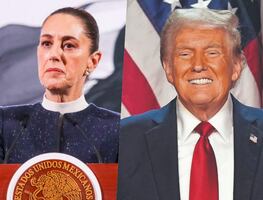Más Información

Sheinbaum responde a Trump sobre declarar a cárteles como organizaciones terroristas; rechaza injerencia extranjera

PAN exige renuncia de Rubén Rocha Moya; Claudia Sheinbaum sigue protegiéndolo en “complicidad vergonzante”

No cesaremos ni nos rendiremos en nuestro llamado a la paz y justicia: Iglesia; pide ser persistentes en exigencia

Con reformas laborales, expertos ven estrategia de Morena; van a fortalecer su número de simpatizantes
On October , U.S. President Donald Trump said that U.S. steel and aluminum tariffs would remain in place for Canada and Mexico until they “can do something different like quotas, perhaps.” However, no change has been made so far.
Mexico’s Steel Producers Association (CANACERO)
informed of a drop in steel production and exports from Mexico to the U.S. last October , due to “an artificial measure that is frankly inconsistent with the principles of free trade and sets a dangerous precedent that infringes its guidelines.”
Since June 1, 2018, the United States applied a tariff of 25% on Mexico, Canada, and Europe’s steel imports . As a retaliatory measure, Mexico taxed several products, including 50 tariff fractions that encompassed steel products, food, and consumer goods .
The Mexican government is now preparing a strategy to negotiate the elimination of tariffs on steel and aluminum imposed by the United States, and will work on the ratification of the new North American Trade Agreement (USMCA) , said the new Minister of Economy, Graciela Márquez Colin .
In her first meeting with media representatives after taking office, the official said that the neighboring country of the north used this mechanism under section 232 for national security reasons , however "we are not a threat," she stressed.
She reiterated that Mexico had expressed its dissatisfaction since the imposition of these tariffs on June 1 , when the government of Donald Trump placed a tax of 25 percent on steel and 10 percent on aluminum to put pressure on Mexico during the renegotiation of NAFTA.
dm







